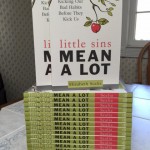The Incorruptible Body of St. Bernadette Soubirous
Victorino Matus wonders:
I thought about other ways a church can revive that sense of awe and mystery as I sat through a mass at the Church of St. Thomas in the Malastranska neighborhood of Prague. (I’m here under the auspices of Radio Free Europe/Radio Liberty and will report on the latest on Iran after meeting the hardworking folks at Radio Farda in a few minutes.) But looking around, I realized no parish would have the money to build golden altars and tabernacles and paintings on the ceiling. But there is one thing I noticed that any church could do and would go a long way to restoring that sense of wonderment:
Glass coffins. You heard me. I noticed two such coffins prominently displayed at St. Thomas. Inside were the bodies of holy men draped in period clothing (I was unable to find out their identities). You couldn’t see actual flesh and bone (or most likely bone) because they were covered from head to toe. Each wore a face mask (one had faded to almost black, the other was gold-colored and reminded me of Destro). I found myself staring at both of these men the entire time. So why can’t we have more glass coffins at our local churches? And when you bring the kids (as David Skinner recently wrote…), you could sit them right in front of these bodies (the ones in St. Thomas were posed on their sides, so they are facing you). I guarantee your children won’t be a disruption at mass anymore. (Well, maybe except for their screams of terror.)
I recently wondered why Bl. Pier Giorgio Frassati’s intact and handsome relic was not encased in a glass coffin when it was included at the World Youth Day in Australia (Frassati was the gathering’s patron).
Incorruptible saints are interesting phenomena, but to my way of thinking the best way to restore the missing sense of mystery, awe and reverence to today’s masses is to pray the liturgy as it is meant to be prayed, without the insertion of our human egos or agendae; finally put to rest the deplorable happy-clappy sentiment of the 1970’s and then worshipping just a little more vertically than horizontally.
But what do I know, I’m just a person in the pew, rolling my eyes when Fr. Feelgood extends the Eucharistic Canon to include his pet philosophies and enduring with quiet grace the choir’s rendition of as deleterious a slab of hymn-sinning as has ever been committed, a singsong that proclaims, “I am here…I am here…I am here…here I am….”
The piece never fails to get me thinking, “I am Sam…I like Ham!”
A little more reverence, a little more silence, a little less “do we all feel good about God…” Would go a long way!
Slightly O/T: Fr. James Martin gives us his reading list for the summer and it includes our old friend Bertie Wooster:
…just so you don’t think I spent all my time with spiritual matters, I’m rereading The Code of the Woosters, one of the many comic novels by P.G. Wodehouse with the characters of Bertram (Bertie) Wooster, the addle-headed British aristo and his much-smarter manservant, Jeeves. You can’t read about the historical Jesus, Vatican II and the Gospels all day, after all.
The collision between Bertie’s slangy argot and Jeeves’ more proper English is always larky. In the midst of a typically bunged-up affair, as Bertie would say, his butler is serenely attending to Bertie’s wardrobe:
Wooster: “You see before you a toad before the harrow.”
Jeeves: “Yes, sir. The trousers perhaps a quarter of an inch higher, sir. One aims at the carelessly graceful break over the instep. It is a matter of the nicest adjustment.”
Wooster: “Like that?”
Jeeves: “Admirable, sir.” I sighed.
Wooster: “There are moments, Jeeves, when one asks oneself, ‘Do trousers matter?’”
Jeeves: The mood will pass, sir.”
More Bertie excerpts here, and a few book recommendations on these glass coffins and witty English trifles.











